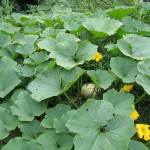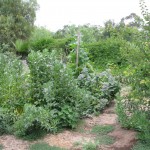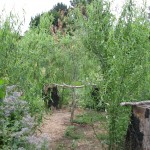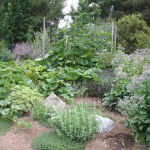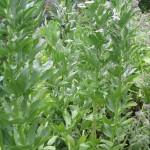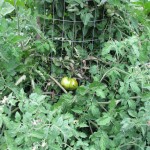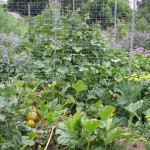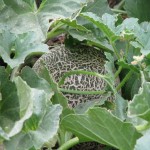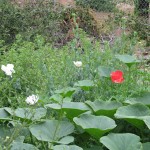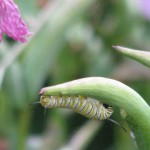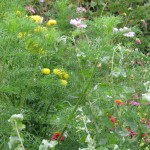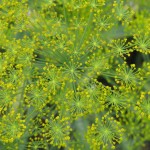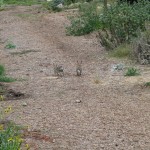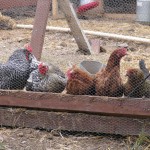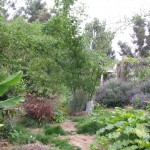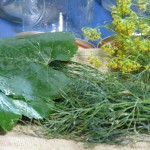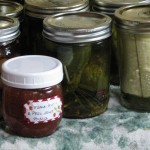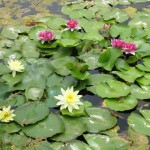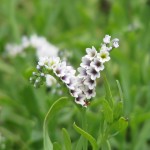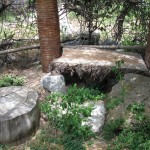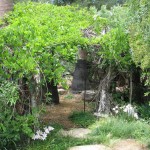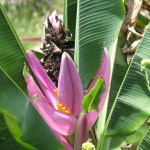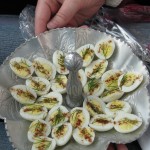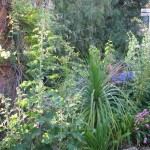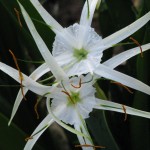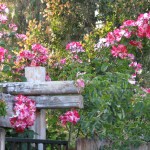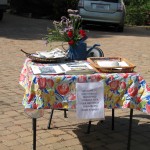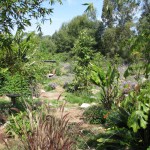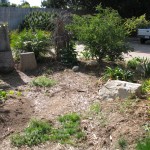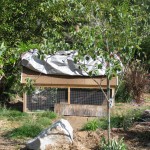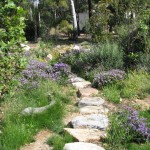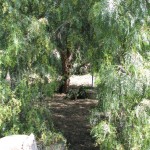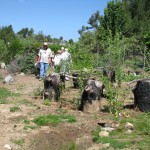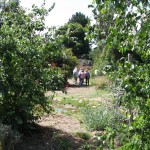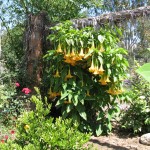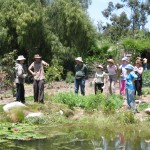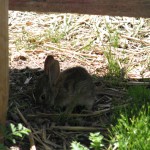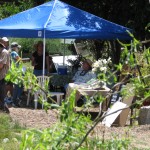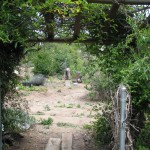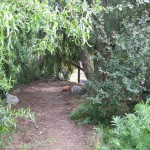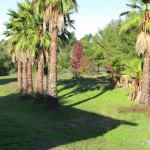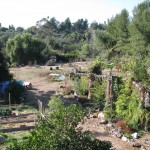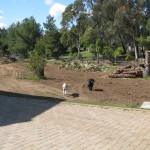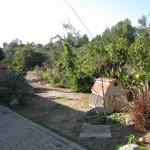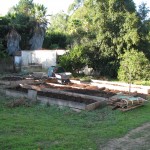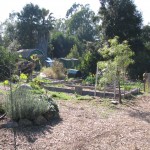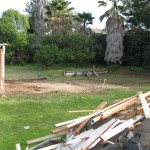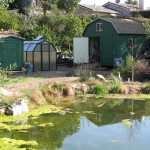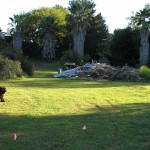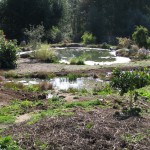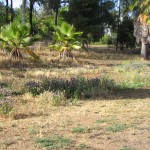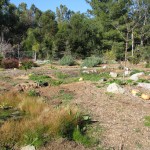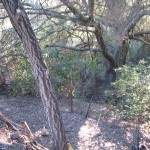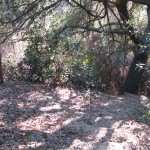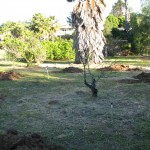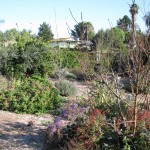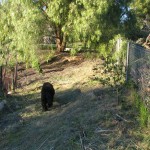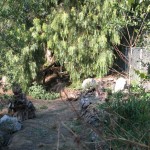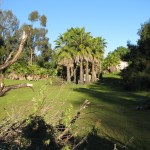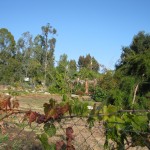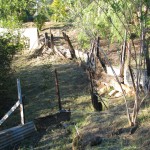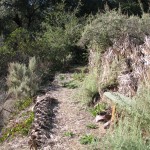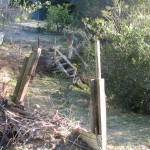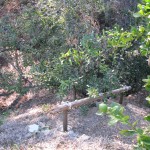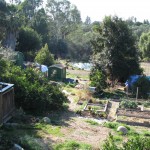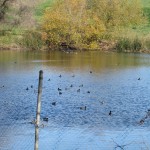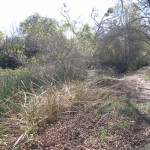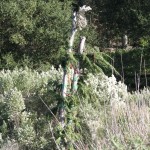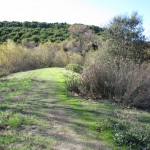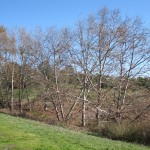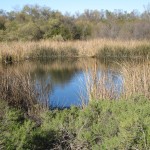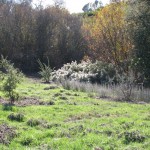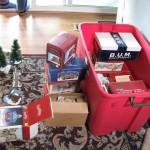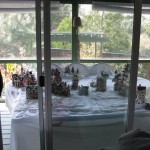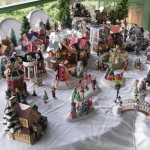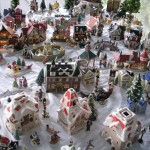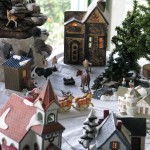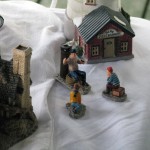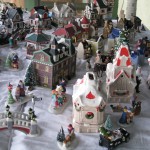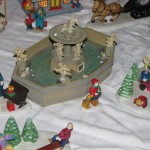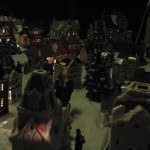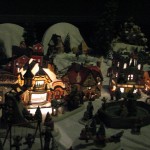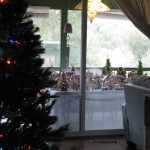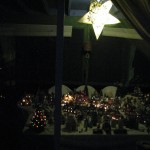Photos
-
Summer Tasks That May Be Too Late To Do

Dutchman’s Pipe eating my lawn chairs. 
The lawn chairs are on the second floor balcony. 
Notice it taking a quick look through the sliding glass door leading into my bedroom, and noticing all that unused space. 
I don’t mention the word c.l.i.p.p.e.r.s. outloud up here. Umm… help! - Animals, Chickens, Gardening adventures, Heirloom Plants, Herbs, Other Insects, Permaculture and Edible Forest Gardening Adventures, Photos, Ponds, Quail, Vegetables
What’s Happening in the July Garden
A banana squash stealthily growing huge An apricot tree with fava beans, squash, herbs, artichokes, and tomatoes The withy hide growing beautifully Kabocha and delicata squash on the ground, zucchino rampicante on the trellis, Christmas beans, favas, Swiss chard and medicinal plants around a small avocado tree Favas: great for the soil, great for the dinnerplate Heirloom tomatoes. Why do they all come ripe at the same time? Sugar pumpkins are ripe already in the Mediterranean guild. Also figs, paste tomato, dill, fennel, thyme, pickling cucumbers and artichoke. Plant guilds of squash, beans, flowers, etc. are flourishing. Heirloom green melons hiding from the hot sun. By now the wild buckwheat has dried up, which starves the bees. But not here. Matilija and Flanders poppies over banana squash Monarchs are so plentiful this year that we have to take pains to avoid them. Wildflowers host an incredible diversity of insects Dill flowers looking like a spectacular firework In a balanced wildlife habitat, bunnys do little harm All five girls waiting for treats in the Fowl Fortress Pumpkins, bananas, bamboo and much more by fescue paths. Fresh grape leaves, dill and garlic from the garden for the pickles Hot weather? Must be canning season! Pickled cucumbers, zucchino and onions, and peach pit and peel jelly. Very large yellow waterlilies Native salt heliotrope by the big pond. Volunteer tomato in the shade of the Nest, by palm tree bench. Wisteria, grapes and zerpheranthum lilies around the Nest Blooming banana Quail eggs! Double heirloom hollyhock Egyptian lilies Fourth of July rose celebrating the holiday -
The Vine that is Eating the Chair

The flowers dangle in the breeze, always watching…. A curiosity plant in my garden is Dutchman’s Pipe (Aristolochia trilobata), also unpoetically called birthwort. The flowers aren’t actually pretty. The politest description of them is that they resemble a large pipe. The flowers dangle in the breeze from the vine, which is evergreen with glossy leaves. It doesn’t produce a fruit.

Kind of like a pipe; kind of like a nose. Dutchman’s Pipe is an ornamental, fast-growing vine that can grow 20 -30 feet in all directions. Including up. Up and up. Onto the second floor balcony. And around everything in its path.

Climbing two stories and beyond. In other words, the vine is eating my balcony and my patio furniture.

I’m glad I wasn’t asleep in it! Dutchman’s Pipe emits weak unpleasant odor when disturbed; otherwise the flowers don’t have a scent. It grows so quickly that the idea of pruning it down is daunting but must be done (… what is that tapping sound I hear on the sliding glass door right now?). It twists and winds around and up the posts to the roof (… hmm… are the cats in the attic again? I’ve never heard them make thatnoise). Soon it will probably be over the roof, and I’ll have an unmanagable amount of vines to clip and haul to the compost heap (… excuse me, someone is at the door. “Hello? Who’s there? Hello?”). I’ve been putting the job off, but today seems like a good day to….. (“What the heck is…. nooo!!…

NOMNOM - Compost, Composting toilet, Gardening adventures, Houses, Natural cleaners, Permaculture and Edible Forest Gardening Adventures, Photos, Soil
I Went to a Garden Potty (adventures with a composting toilet)
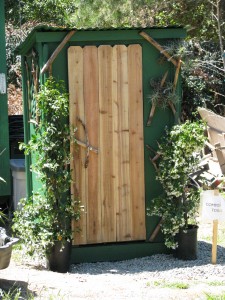
A very pretty outhouse! I asked Roger Boddaert to have his men build a simple composting toilet out of the scraps of wood left over from my sheds. This is what he came up with! It is a gorgeous little building painted to match the sheds. Wood features stand out decoratively, and two cloud-shaped windows covered with trellis adorn the sides. Good for ventilation and for watching birds on the pond!
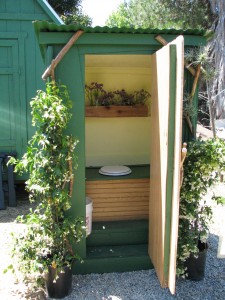
Inside there is a $5 toilet seat on a bench that conceals a bucket. Inside is a raised seat that conceals a bucket underneath. The least expensive toilet seat I could find is attached to smoothed wood. Above the seat Roger attached a shelf with flower pots. I stashed the organic cleaner bottle and extra toilet paper behind some cut status flowers.

In the back you can see the bucket placed high enough to prevent accidents. Underneath is a Home Depot bucket, with the lid close at hand. I had to make it stand taller by shoving boards underneath so that there weren’t any room for mistakes.
The way a composting toilet works, is that you do your business, including the toilet paper, and then add a scoop of organic material to the bucket equal to what you had put in there. That’s it. The organic material can be sawdust, wood shavings for pet bedding, compost, etc. As long as it is easily scoopable.
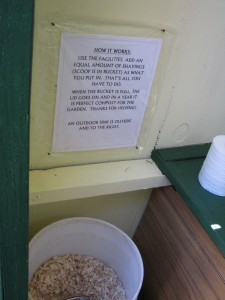
When the bucket is full, you put the lid on and store it for a year. Or you can dig a deep hole, dump the bucket in, cover it up and mark it, and in a year plant on it or use it otherwise. I don’t have the exact science for this, but within a year all those microbes will consume the humanure and neutralize all the stuff that is in there that could be harmful, such as medicines. Very simple, very clean, very useful.
Composting toilets – the ones that look like real toilets – are tremendously expensive and not that efficient. What a waste of money! The bucket system is amazingly efficient. I have visited several, one a private one and the others at Audubon preserves. There are no flies, no smells. My outhouse was used a lot during the Garden Tour last Saturday, and I peeked in there today to check. Smells great! No flies.
The outhouses at the Audubon centers have the same system, but on a larger scale for more visitors. Instead of a bucket there is a wheeled compost bin underneath. One in rainy Oregon was a solar composting toilet, where part of the bin was under the toilet seat, and the rest under clear corrugated plastic roofing that amplified the ambient light and helped ‘cook’ the compost. The waste in the bin was stirred around frequently with the compost so that it could cook better. Still no smell, no mess.
Simple solutions are there for everything, and through studying permaculture and seeing what works for other people is very enlightening. The answer rarely has to be expensive. And, as is my new outhouse, it can be fun, too.
- Animals, Bees, Birding, Chickens, Compost, Gardening adventures, Health, Other Insects, Permaculture and Edible Forest Gardening Adventures, Photos, Ponds, Quail, Rain Catching, Reptiles and Amphibians, Soil
I Went to a Garden Party….

AAUW Garden Tour Saturday was the AAUW Garden Tour. What a glorious day. I expected about a hundred visitors, and made 120 handouts. Sometime in the early afternoon I guess they ran out, and I didn’t know about it for awhile. I made 25 more for the last two hours, and have five left. One of the docents said that some had been turned back in during the morning. Every couple probably took just one… wow, that’s a lot of people.
I’d been talking to the garden all week, asking the blooming plants to hold that thought for a few more days, and encouraging the nonblooming ones to get a move on. The plants did what I asked! There were so many flowers out Saturday, it was amazing. Heirloom roses, Gideon’s Trumpet, ranunculus, herbs, wildflowers, and waterlilies. The garden, apparently, also was also all for proof in advertising, as in standing behind the NWF Habitat sign on the front gate. So many kinds of butterflies and dragonflies were out for the first time this year that people remarked on it. In the afternoon, there were sightings of a king snake all over the property; I think it had to have been three kingsnakes. One was moved from the refreshment area, but he came back, and then as I was standing by the pond talking to some ladies one came past us. Another was sighted up in the driveway. Roger sighted a gopher snake. No one shrieked or complained; either these were hardy people, or the idea that this was a habitat yard made them keep calm. It also backed up my claims of letting snakes deal with gophers and rodents! One man spotted a baby bunny under the Withy Hide bench. By one o’clock, it was funny. It was as if a button had been pressed to turn the garden on, and all the features were working! What a glorious day.
Jacob (Aquascape Associates) and Roger (landscape architect) and I answered questions for most of the day; the last four visitors left at four. So many people asked questions about permaculture, soil, beekeeping, cob ovens and rain catchment that I know that I couldn’t answer everyone’s questions. Of course there were some who like a tidy, orderly garden, and that is fine. If everyone came away with some idea how to work with nature rather against it, to use chemicals less, to grow organic food, to repurpose, to compost their kitchen waste and weeds, then what a lot of small ripples of good will come of it.
Thank you to my dear friends who helped prepare the garden so that it looked stunning. And thank you to the snakes, butterflies, bees, dragonflies, birds, bunnies and who-knows-what-else that came out to perform for the visitors! And thank you to everyone who visited! No casualities; all good.
Here are some photos, although my camera doesn’t do the colors justice:
AAUW Garden Tour Welcome! Look at photos of how it was. Main entrance walkway Walkway into the Nest One of the many trails A palm sitting stump between guilds by the driveway A green melon under variegated lemon, with native grasses. Quail hut, with privacy boards up. Status and wildflowers across the stone walkway Cool spot under the upper pepper tree Roger and visitors by the Withy Hide Some of the first visitors of many Pickerel blooming in the little pond Gideon’s Trumpet keeping blooms and aroma until the tour Jacob teaching about natural ponds Baby bunny under the Withy Hide bench Roger answering questions View from the Bee Garden gate Cool spot under the pepper tree -
Harry Mud Has a New Look
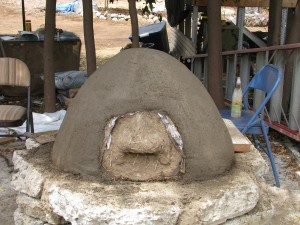
Harry Mud with his bald pate This morning a Meetup was held at my property (Finch Frolic) for the San Diego Permaculture group (http://www.meetup.com/SanDiegoPermaculture/ ). The agenda was to tour the garden and build the second layer – the insulation layer – on Harry Mud, the cob (earthen) oven begun at a similar Meetup last July. There are three installments posted on my blog; you can search for cob oven, or read about the third installment here: http://www.vegetariat.com/2011/07/cob-oven-3/ ) (sorry, I can’t seem to get the hyperlink to work).
During all this time Harry has patiently sat under his tarp awaiting a second layer. Today was his day.
One of the reasons I wanted to work on Harry is that my garden will be on the Association of University Women’s garden tour on May 12th (OMG! Only four weeks away!!!). I’m hoping to inspire a lot of people to research permaculture for their own properties, and to show off earthen building. Harry will be a star.
With 29 people signed up to come today and projected rainshowers, I scrambled a bit to make sure there would be cobbing opportunities for all. However about 15 people toured, the weather although windy was dry and beautiful, and all goals were accomplished. Hopefully everyone came away with what they wanted to hear about, and not so much dog poo on their shoes.
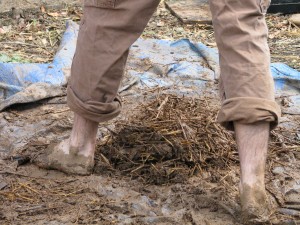
A dirt and straw pedicure. Although I enjoy speaking with groups of people, the drawback is that I don’t have the chance to speak with individuals and find out their stories or learn from them. Everyone has wells of experience and tidbits of knowledge (or buckets full!), and you never know how your life can change with just a passing comment or chance encounter.
Anyway, many of us had mud manicures and pedicures, the group dwindled, and Harry became even more handsome, if that is even possible. Three intrepid souls stayed for Harry’ First Fire, and we lunched and chatted about all kinds of interesting topics, such as communication between plants. It was a good day. Now that I’ve soaked the mud off of myself in a hot bath with epsom salts, I’ll show you what went on.

Sifted soil in wheelbarrow being resifted through smaller mesh. To create the insulation layer, we sifted dirt through two progressively smaller screens.
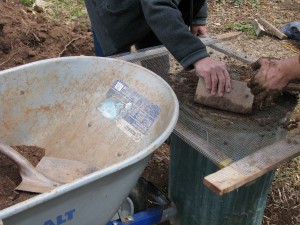
Screening dirt. That was mixed with water and a lot of straw, which took a lot of time but was fun.

Fancy cob footwork. Cob is a community event. That cob mixture was formed in a four-inch layer around Harry.

Harry looks as if he's going bald, but he's actually getting a straw afro! Just in case all 29 people showed up, I had prepared an extra cob project. I thought a work table next to the oven would be a good idea, so stacked two old tires, topped by a tire with the wheel still in there. These had been part of the fill on my property when I moved in 13 years ago. Two intrepid permaculturalists then filled the inside with rubble (small bits of urbanite left over from walls) and sand left over from Harry Mud. A piece of wood was propped in the center to hold the top in place. At some point the entire thing will be cobbed.

Filling stacked tires with cement rubble and sand for future cob table. Harry’s First Fire was set. Handsome, isn’t he?
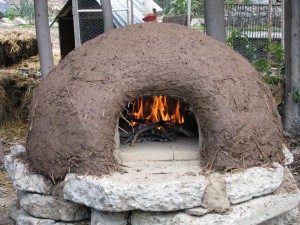
Harry Mud, all fired up! He is a little thicker towards the bottom (I know how he feels!) because the mixture slumps a little, but he’s thick enough all over to insulate well. Harry will eventually receive a slip coating on the outside, which will help protect the insulation layer and be decorative. The urbanite base will be covered as well. I’d like a shade structure over the area, built out of the shed leftovers of which I have plenty. Harry will have to be protected from rain by a tarp as usual.
Thank you everyone who helped out!
-
Valentine Flowers

Freesia, one of my favorite flower scents. Although I don’t really like Valentine’s Day, I do like the fact that spring starts here in San Diego County in February. So to celebrate the day and the season, I thought I’d post photos of some new blooms that I took after our brief… and all too rare… rainstorm today.

Cyclamen and freesia. This cyclamen had been a gift from my good friend Eileen several years ago, and every year it never fails to glow.

Strawflowers. These bright gold beauties are left overs from seed mixtures I planted at the end of last summer. Borage is the big-leafed plant behind, also in bloom.

Queen Anne's Double Jonquil bud (heirloom). Over my thirteen years at this house I’ve collected heirloom bulbs and heirloom roses, even during the years when I really couldn’t afford to spend twenty dollars on something frivolous. Heirloom plants make me happy, and make me feel as if I’m contributing to the conservation of forgotten plants.

Ice Follies heirloom daffodil I buy all my heirloom bulbs from Old House Gardens (www.oldhousegardens.com). Visit them online, order a print catalog and indulge in the humor, the history and the sheer beauty of what this small company offers.

Saint Keverne heirloom daffodil. I have, as you might have guessed, a great fondness for daffodils. That includes jonquils and narcissus, of course. They are such happy, homely flowers; beautiful in their unusual form, and such a bright harbinger of spring! I’ve planted cheaper, non-heirloom daffs all around trees throughout my gardens and along my driveway. The heirloom ones I have separated in my front yard.

Louise de Coligny heirloom daffodil. We don’t have many native bulbs in Southern California. That is logical, since we don’t have severe winters and plants never had to store their resources underground, protected from snow and ice. Many of our flower seeds, such as those of California poppies, need light to germinate and are best sown right on the ground. So bulbs such as my lovely daffodils don’t quite fit into a native garden, but instead remind me of colder climates. Also, gophers won’t eat the poisonous daffodil bulbs!

California redbud tree Several trees are breaking out in bloom; the crabapples around the pond, several apple trees, a plum, and this California redbud. I’m not thrilled about redbuds, but they do offer spring flower color, nice summer foliage, and fall color. What I like best about them is that they are nitrogen fixers, and improve the soil all around their roots.

Calla lily Far too early for Easter, this Calla Lily appeared this week and made me remember my mother, who always bought them for spring. Mom’s favorite color was white, and although not her favorite flower (which was the orchid), the Calla lily seems the most like her: clean lines, unique shape and the glowing whiteness of sophistication.

Single heirloom freesia. Freesia is one of my favorite flower scents. It is fresh and not cloying or heavy. My other very favorite scents are yellow primrose (only the yellow ones have a fragrance!) and sweet violets (my favorite flower). And, of course, roses. The form that the freesia flower stalk takes, almost serpentile, adds so much to a garden’s shape. I like the yellow freesia the best, and they are also the most fragrant.

Ivy Geranium Growing up, I used to hate geraniums. Martha Washington and ivy geraniums covered the embankment of the backyard of the tract house we lived in in Carlsbad, CA. Every time a ball was lost in it, or one of our Shelties ran through them, the obnoxious smell of the geranium leaves was overwhelming to me. As I matured, however, I found out what a reliable friend geraniums can be. They take so much abuse and yet bloom all year ’round. The bright and dark reds are stunning and add just the right touch to other color combinations. I still prefer the less smelly vining ivy geraniums over the big-leaved Martha Washington varieties, and I let them clamber over my chain link fence, turning an eyesore into a trellis for beauty.
I hope my bouquet of flowers makes you happy. Happy Valentine’s Day!
- Animals, Bees, Birding, Chickens, Gardening adventures, Heirloom Plants, Other Insects, Permaculture and Edible Forest Gardening Adventures, Photos, Ponds, Rain Catching, Vegan, Vegetables, Vegetarian
Garden’s One Year Anniversary
Happy Anniversary! One year ago on Feb. 1, 2011, I signed a contract with landscape architect Roger Boddaert (760-728-4297) to create a permaculture garden. For twelve years I’ve had this sloping property that was covered in weeds and worthless Washingtonia palms. Not only do these 2 acres slope down to a barranca, but it was filled in due to catching all the rainwater that runs from the street and properties above. I have to give credit to friend Gary B., who brought up the subject of permaculture in a conversation the year before. I’d heard the term and thought I knew what it was about, but months later when I was researching what to do with my property I remembered him mentioning it, and looked it up. I found what I was looking for. I’ve been an organic gardener for many years, have owned chickens for their eggs, have refused to till the soil so as not to kill microbes, have worked naturally with animals and plants, have created habitat, composted, recycled, collected rainwater… and all of that was permaculture. And so much more. How can one not be attracted to the term Food Forest? Certainly not a foodie and gardener like myself.
What happened on the property starting the week of Feb. 1 for the next six months altered the land so that it is truly two acres of habitat. It is useful, it is natural, and it is beautiful. Roger’s team led by Juan built beautiful walls of urbanite, planted and hauled, worked in scorching sun and frosty mornings and made what was dreamed into reality. An integral part of the garden has been diverting the water from erosion points and into rain catchment basins and natural ponds, and that is where Aart DeVos and Jacob Hatch of Aquascape (760-917-7457) came in. They also installed the irrigation. Dan Barnes did the rough and the precise tractor work (760-731-0985) and I can’t recommend his experience and skill enough. Fain Drilling dug the well (760-522-7419) and the wonderful sheds were built by Quality Sheds of Menifee (http://www.socalsheds.com) .
Along with some volunteer help from Jacob, I am the sole caretaker of the property. I am planning the plant guilds, weeding, improving soil, moving problem plants and trees and, did I mention, weed? Oh yes, then there is weeding. On Saturday May 12th, the garden will be on the Garden Tour of the Association of University Women of Fallbrook, and hopefully many people will be inspired to go organic, to create habitat, conserve water and grow extra food for the Fallbrook Food Pantry. We’ve come a long way, baby!
The following photos are comparisons between the precise location last year at this time, and today.
The property last February. The property today. Sophie and General loved all the excitement. They love the new gardens and pond even more. My veggie beds with the old sheds behind. My veggie beds with the new sheds and greenhouse behind. Where the big sheds were: everything usable was reused. New sheds that aren’t a safety hazard, and the greenhouse. The lower area with shed debris (lots of mowing area!). Hey, there are ponds there now! Not much for the neighbors to look at. Quite a lot for the neighbors to look at! Access to the old oak was hazardous. Palm stairs lead past the oak to a birding area. Stonefruit were old when I moved in. New stonefruit adorn what is now the Bee Garden. An erosion area sloping down to the barranca. Water won’t flow through here anymore. Lots of mowing and palm frond removal. Not so anymore. Horrible looking debris failed to hold back the embankment. Palms were used to stabilize the new paths and camoflage the supports. Old unstable stairs led to washout areas. New railings, stairs and urbanite retaining walls lead to another viewing area. The view from my balcony. Part of the old shed remains. Hey, there’s a pond there! -
December in Fallbrook
Coots on the pond Sunlight in the sleeping willows. Tranquility (try not to look at the houses). Tough and determined roots being fed by decaying golden leaves. An impromptu Christmas tree: a snag decorated with juniper, cranberries and bird seed. Lush green weeds keeping a low profile in the winter. Stately sycamores; their leaves shed to keep their roots warm. A season of greens, golds and blues. Coyote bush seed fluff glowing white instead of snow. -
Christmas Town
I love Christmas. I am a sucker for Christmas decorations. Slowly over the years, attending after-holiday sales, I added to the Christmas decorations for me and my children. Every year for many years I would let my son and daughter pick out a Hallmark Christmas ornament of their own. Our tree is decorated with the Three Stooges, a Klingon Battlecruiser, an Enterprise Shuttlecraft, and a Mole Christmas. In fact, when the tree is plugged in three voices chime in: one is saying, “Shuttle craft to Enterprise, shuttle craft to Enterprise. Spock here. Happy Holidays. Live long and prosper.” Another is Worf from Next Generation saying, “I wish you a most honorable holiday. Ka-plah.” Thirdly, and no less spectacularly, is, “Roger. Zero G and I feel fine. Capsule is turning around. Oh! That view is tremendous!” That was astronaut John Glenn in 1962 in the Friendship-7 shuttle, having the first view of the earth by a man in space.
The most labor-intensive part of the Christmas set-up, yet the most satisfying, is Christmas town. Years of going to Michael’s crafts store after Christmas to pick up the Dickensville Christmas town piece by piece, along with small houses collected along the way (I always have had a weakness for miniature houses), has coalesced into a city that, if not always size appropriate, certainly is well planned. My son used to set up the town, then after he moved out my daughter took over the planning. There is a business district, a central park area, the docks, a residential neighborhood, both upscale and poor, alleyways, and off in the mountains stands Scrooge in front of his dark home watching with hopefully spirit-changing surprise as Santa and his reindeer fly past. The town changes every year. It is always good to see the familiar faces: a mother and daughter feeding the birds, boys on a teeter-totter, and a little man just standing there having a cup of tea. Then in January, I pack it all away again, and enjoy having my house a little less cluttered for the New Year.
One of five boxes for the town. The B.U.M. box is where Scrooge’s house is stored. Just beginning to plan it out. Uptown. Districts seperated by roads and alleys. Toy factory in front of the skating rink. Scrooge outside his dark house in the mountains, with Santa! Telling tall tales by the dock. The blue-collar side of town. Feeding birds and playing by the town fountain. A man having a cuppa by the alleyways. Businesses open after dark. Loading a sleigh full of presents. Finished town during the day Town at night.
